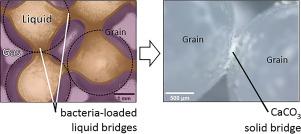Foam-based microbially-induced calcite precipitation
Q3 Materials Science
引用次数: 0
Abstract
Building on the development history of the Microbially Induced Calcite Precipitation (MICP) method and recent insights into the organization of liquid and bubbles within pore spaces filled with liquid foam, we hypothesize a potential synergy between MICP and liquid foam for enhancing soil properties. We assess the respiration and calcification capabilities of the bacterium Sporosarcina pasteurii in various foaming solutions formulated with bio-based surfactants. The most promising formulations are then used for in-situ observations of bacteria-induced calcification within foam-embedded 2D granular packings. We observe that maltoside-type AlkylPolyGlucosides with relatively short chains, in particular, enable optimal calcification in less than an hour. In the granular packing, the foam spontaneously creates liquid zones enriched with bacteria at the inter-grain contacts. As a result, instead of being distributed across the entire porous space, calcification is localized in these zones, promoting the formation of solid bridges (CaCO). This suggests that the foam-based MICP method could represent a relevant variation of the original approach, though this remains to be confirmed at larger scales through mechanical testing on representative soil samples.

基于泡沫的微生物诱导方解石沉淀
基于微生物诱导方解石沉淀(MICP)方法的发展历史和最近对液体泡沫填充的孔隙空间中液体和气泡组织的见解,我们假设MICP和液体泡沫之间存在潜在的协同作用,以增强土壤性质。我们评估了细菌的呼吸和钙化能力巴氏孢子孢杆菌在不同的发泡溶液配制的生物基表面活性剂。最有希望的配方随后被用于在泡沫嵌入的二维颗粒填料中原位观察细菌诱导的钙化。我们观察到具有相对较短链的麦芽糖型烷基多糖苷,特别是在不到一小时的时间内实现最佳钙化。在颗粒填料中,泡沫自发地在颗粒间接触处产生富含细菌的液体区。因此,钙化不是分布在整个多孔空间,而是局限于这些区域,促进了固体桥(CaCO3)的形成。这表明基于泡沫的MICP方法可以代表原始方法的相关变化,尽管这仍有待于通过对代表性土壤样品进行更大规模的机械测试来证实。
本文章由计算机程序翻译,如有差异,请以英文原文为准。
求助全文
约1分钟内获得全文
求助全文
来源期刊

JCIS open
Physical and Theoretical Chemistry, Colloid and Surface Chemistry, Surfaces, Coatings and Films
CiteScore
4.10
自引率
0.00%
发文量
0
审稿时长
36 days
 求助内容:
求助内容: 应助结果提醒方式:
应助结果提醒方式:


